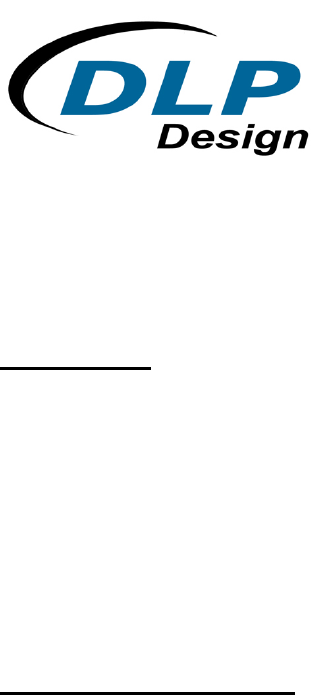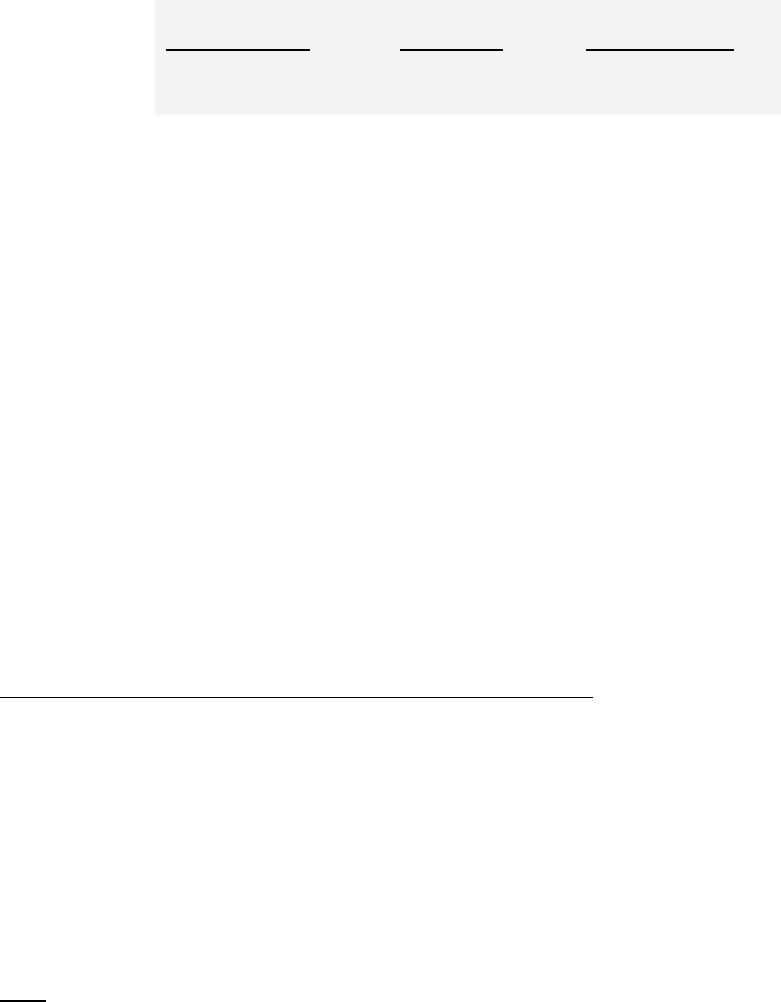DLP Design RFS1 Module User Manual DLP RFS1231 Datasheet
DLP Design, Inc. Module DLP RFS1231 Datasheet
Installation manual

Rev 1.1 (April 2009) 1 © DLP Design, Inc.
D
DL
LP
P-
-
R
RF
FS
S1
12
23
31
1
LEAD FREE
9
90
02
2-
-9
92
28
8M
MH
Hz
z
D
Da
at
ta
a
R
Ra
ad
di
io
o
**PRELIMINARY DOCUMENT-SUBJECT TO CHANGE**
FEATURES:
• 31 Channel FHSS
• 17dBm Output Power
• 1 Mile Range
• U.FL Antenna Connector
• On-Board Antenna
• FCC/IC/CE Modular Approval In Place
• Permanent, Unique Serial Number Built in
• Single 3.3 Volt Supply
APPLICATION AREAS:
• Real-Time Security
• Body-worn Medical Telemetry
• Battery-Powered Home Automation
• Electric/Water/Gas Automated Meter Reading
• Industrial Monitoring And Control
• Active RFID
• Long Range Battery-Powered Multi-Hop Sensor Networks
1.0 INTRODUCTION
The DLP-RFS1231 is a low-cost module for transmitting and receiving digital
data via radio frequency. All of the DLP-RFS1231’s electronics (including an antenna)
reside on a single PCB, and all operational power is derived from a single 3.3 volt
supply.
The transceiver design is made up of a Renesas RL78 low-power microcontroller
(R5F100EEANA), a Semtech SX1231 low power, integrated UHF transceiver and an
antenna switch for selecting between the on-board antenna and an optional external
antenna. The hardware is designed for maximum range and optimum battery life.

Rev 1.1 (April 2009) 2 © DLP Design, Inc.
2.0 SPECIFICATIONS
Reader Frequency 902-928MHz
Output Power 50mW (17dBm) MAX
Range Up to 1 mile (Depends upon the antenna used)
Protocol Frequency Hopping, Spread Spectrum
Communications Interface TTL Serial
Operational Power – Active TBDmA
Operational Power – Idle TBDmA
Antenna Connector u.fl*
Operating Temperature 0-70°C
*Please see the Antenna Section for important regulatory details.
3.0 SERIAL NUMBER
Each DLP-RFS1231 contains a unique, 48-bit, hard-coded serial number that cannot be altered
by any means. The serial number can be read via the microcontroller and used to identify the
transceiver in the transmitted packets.
4.0 APPLICATION DEVELOPMENT
A software library is available for free download upon purchase of the DLP-RFS1231 that
demonstrates reading the serial number, transmitting and receiving data packets and setting up
simple point-to-point and star networks.

Rev 1.1 (April 2009) 3 © DLP Design, Inc.
5.0 REGULATORY AGENCY CONSIDERATIONS
5.1 AGENCY IDENTIFICATION NUMBERS
Compliance with the appropriate regulatory agencies is essential in the deployment of all
transceiver devices. DLP Design has obtained modular approval for this RF product. As such,
an OEM need only meet a few basic requirements in order to utilize their end product under this
approval. Corresponding agency identification numbers will be listed below:
Part Number US / FCC CANADA / IC
DLP-RFS1231 SX9RFS1 5675A-RFS1
5.2 EXTERNAL ANTENNAS
The DLP-RFS1231 is pre-approved for use with both its on-board chip antenna and an external
antenna part number 0600-00048 made by Laird Technologies. Connection to the external
antenna is made via a u.fl connector.
5.3 FCC/IC REQUIREMENTS FOR MODULAR APPROVAL
Any changes or modifications to the DLP-RFS1231’s printed circuit board, on-board antenna, or
pre-approved external antenna could void the user’s authority to operate the equipment.
5.4 WARNINGS
Operation is subject to the following two conditions: (1) This device may not cause harmful
interference, and (2) this device must accept any interference received, including interference
that may cause undesirable operation.
This device is intended for use under the following conditions:
1. The transmitter module may not be co-located with any other transmitter or antenna; and,
2. The module will be approved using the FCC’s “unlicensed modular transmitter approval”
method.
As long as these two conditions are met, further transmitter testing will not be required.
However, the OEM integrator is still responsible for testing their end product for any additional
compliance measures necessitated by the installation of this module (i.e. digital device
emissions, PC peripheral requirements, etc.).
Note: In the event that these conditions cannot be met (i.e. co-location with another
transmitter), then the FCC authorization is no longer valid, and the corresponding FCC ID may
Rev 1.1 (April 2009) 4 © DLP Design, Inc.
not be used on the final product. Under these circumstances, the OEM integrator will be
responsible for re-evaluating the end product (including the transmitter) and obtaining a
separate FCC authorization.
5.5 OEM PRODUCT LABELING
The final end product must be labeled in a visible area with the following text:
“Contains TX FCC ID: SX9RFS1”
5.6 RF EXPOSURE
In order to comply with FCC RF exposure requirements, the antenna used for this transmitter
must not be co-located or operating in conjunction with any other antenna or transmitter.
5.7 ADDITIONAL INFORMATION FOR OEM INTEGRATORS
The end user should NOT be provided with any instructions on how to remove or install the
DLP-RFS1231. This device will be pre-certified to operate with the antenna models listed
below:
• On-board Chip Antenna
• Laird Technologies P/N 0600-00048
6.0 DISCLAMER
Neither the whole nor any part of the information contained herein nor the product described in
this datasheet may be adapted or reproduced in any material or electronic form without the prior
written consent of the copyright holder.
This product and its documentation are supplied on an as-is basis, and no warranty as to their
suitability for any particular purpose is either made or implied. DLP Design will not accept any
claim for damages whatsoever arising as a result of the use or failure of this product. Your
statutory rights are not affected.
This product or any variant of it is not intended for use in any medical appliance, device or
system in which the failure of the product might reasonably be expected to result in personal
injury.
This document provides preliminary information that may be subject to change without notice.
Rev 1.1 (April 2009) 5 © DLP Design, Inc.
7.0 CONTACT INFORMATION
DLP Design, Inc.
1605 Roma Lane
Allen, TX 75013
Phone: 469-964-8027
Fax: 415-901-4859
Email: support@dlpdesign.com
Internet: http://www.dlpdesign.com